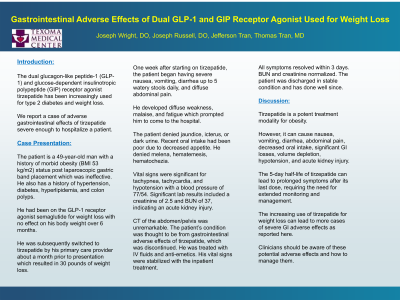Tuesday Poster Session
Category: Obesity
P4892 - Gastrointestinal Adverse Effects of Dual GLP-1 and GIP Receptor Agonist Used for Weight Loss
Tuesday, October 29, 2024
10:30 AM - 4:00 PM ET
Location: Exhibit Hall E

Has Audio
- JT
Jefferson Tran, MD
TMC
Denison, TX
Presenting Author(s)
Joseph Wright, DO1, Joseph Russell, DO1, Jefferson Tran, 2, Thomas Tran, MD1
1TMC, Denison, TX; 2TMC, Sherman, TX
Introduction: The dual glucagon-like peptide-1 (GLP-1) and glucose-dependent insulinotropic polypeptide (GIP) receptor agonist tirzepatide has been increasingly used for type 2 diabetes and weight loss. We report a case of adverse gastrointestinal effects of tirzepatide severe enough to hospitalize a patient.
Case Description/Methods: The patient is a 49-year-old man with a history of morbid obesity (BMI 53 kg/m2) status post laparoscopic gastric band placement which was ineffective. He also has a history of hypertension, diabetes, hyperlipidemia, and colon polyps. He had been on the GLP-1 receptor agonist semaglutide for weight loss with no effect on his body weight over 6 months. He was subsequently switched to tirzepatide by his primary care provider about a month prior to presentation which resulted in 30 pounds of weight loss. One week after starting on tirzepatide, the patient began having severe nausea, vomiting, diarrhea up to 5 watery stools daily, and diffuse abdominal pain. He developed diffuse weakness, malaise, and fatigue which prompted him to come to the hospital. The patient denied jaundice, icterus, or dark urine. Recent oral intake had been poor due to decreased appetite. He denied melena, hematemesis, hematochezia. Vital signs were significant for tachypnea, tachycardia, and hypotension with a blood pressure of 77/54. Significant lab results included a creatinine of 2.5 and BUN of 37, indicating an acute kidney injury. CT of the abdomen/pelvis was unremarkable. The patient’s condition was thought to be from gastrointestinal adverse effects of tirzepatide, which was discontinued. He was treated with IV fluids and anti-emetics. His vital signs were stabilized with the inpatient treatment. All symptoms resolved within 3 days. BUN and creatinine normalized. The patient was discharged in stable condition and has done well since.
Discussion: Tirzepatide is a potent treatment modality for obesity. However, it can cause nausea, vomiting, diarrhea, abdominal pain, decreased oral intake, significant GI losses, volume depletion, hypotension, and acute kidney injury. The 5-day half-life of tirzepatide can lead to prolonged symptoms after its last dose, requiring the need for extended monitoring and management. The increasing use of tirzepatide for weight loss can lead to more cases of severe GI adverse effects as reported here. Clinicians should be aware of these potential adverse effects and how to manage them.
Disclosures:
Joseph Wright, DO1, Joseph Russell, DO1, Jefferson Tran, 2, Thomas Tran, MD1. P4892 - Gastrointestinal Adverse Effects of Dual GLP-1 and GIP Receptor Agonist Used for Weight Loss, ACG 2024 Annual Scientific Meeting Abstracts. Philadelphia, PA: American College of Gastroenterology.
1TMC, Denison, TX; 2TMC, Sherman, TX
Introduction: The dual glucagon-like peptide-1 (GLP-1) and glucose-dependent insulinotropic polypeptide (GIP) receptor agonist tirzepatide has been increasingly used for type 2 diabetes and weight loss. We report a case of adverse gastrointestinal effects of tirzepatide severe enough to hospitalize a patient.
Case Description/Methods: The patient is a 49-year-old man with a history of morbid obesity (BMI 53 kg/m2) status post laparoscopic gastric band placement which was ineffective. He also has a history of hypertension, diabetes, hyperlipidemia, and colon polyps. He had been on the GLP-1 receptor agonist semaglutide for weight loss with no effect on his body weight over 6 months. He was subsequently switched to tirzepatide by his primary care provider about a month prior to presentation which resulted in 30 pounds of weight loss. One week after starting on tirzepatide, the patient began having severe nausea, vomiting, diarrhea up to 5 watery stools daily, and diffuse abdominal pain. He developed diffuse weakness, malaise, and fatigue which prompted him to come to the hospital. The patient denied jaundice, icterus, or dark urine. Recent oral intake had been poor due to decreased appetite. He denied melena, hematemesis, hematochezia. Vital signs were significant for tachypnea, tachycardia, and hypotension with a blood pressure of 77/54. Significant lab results included a creatinine of 2.5 and BUN of 37, indicating an acute kidney injury. CT of the abdomen/pelvis was unremarkable. The patient’s condition was thought to be from gastrointestinal adverse effects of tirzepatide, which was discontinued. He was treated with IV fluids and anti-emetics. His vital signs were stabilized with the inpatient treatment. All symptoms resolved within 3 days. BUN and creatinine normalized. The patient was discharged in stable condition and has done well since.
Discussion: Tirzepatide is a potent treatment modality for obesity. However, it can cause nausea, vomiting, diarrhea, abdominal pain, decreased oral intake, significant GI losses, volume depletion, hypotension, and acute kidney injury. The 5-day half-life of tirzepatide can lead to prolonged symptoms after its last dose, requiring the need for extended monitoring and management. The increasing use of tirzepatide for weight loss can lead to more cases of severe GI adverse effects as reported here. Clinicians should be aware of these potential adverse effects and how to manage them.
Disclosures:
Joseph Wright indicated no relevant financial relationships.
Joseph Russell indicated no relevant financial relationships.
Jefferson Tran indicated no relevant financial relationships.
Thomas Tran indicated no relevant financial relationships.
Joseph Wright, DO1, Joseph Russell, DO1, Jefferson Tran, 2, Thomas Tran, MD1. P4892 - Gastrointestinal Adverse Effects of Dual GLP-1 and GIP Receptor Agonist Used for Weight Loss, ACG 2024 Annual Scientific Meeting Abstracts. Philadelphia, PA: American College of Gastroenterology.
